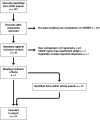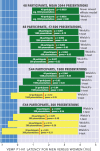Novel cVEMP procedure reveals sexual dimorphism in peak to trough latency
- PMID: 40271199
- PMCID: PMC12014665
- DOI: 10.3389/fnint.2025.1454924
Novel cVEMP procedure reveals sexual dimorphism in peak to trough latency
Abstract
Introduction: Sex difference in latency for cervical vestibular-evoked myogenic potential (VEMP) has been reported in Brown Norway rats. Human investigations of sex difference in VEMP latency have shown inconsistent results, although there are indicators of sexual dimorphism in vestibular function and a higher reporting rate for vestibular disorder in women than in men.
Methods: Sex effects in human VEMP were re-evaluated here using a procedure adapting clinical protocols for higher sensitivity. VEMP was compared between 24 women and 24 men using a novel procedure that (1) controlled neck tension with biofeedback and a padded head bar; (2) used body-conducted stimuli to eliminate sound exposure concerns and collect appreciably more data than is feasible with air-conducted stimuli; which in turn (3) increased statistical power because there were sufficient data for a linear mixed effects regression modelling analysis.
Results: Women had significantly shorter VEMP peak to trough latency than men. The sex difference of 2.4 ms (95% CI [-0.9, -3.9], p = 0.0020) was 21% of the mean 11.4 ms VEMP peak to trough latency measured across women and men. There was no significant sex difference in VEMP peak to trough amplitude. These findings are a reversal of several prior studies in humans, reviewed here with a simulation indicating the studies may have been underpowered.
Discussion: Findings are consistent with those in Brown Norway Rats, for which a study design featuring a custom rodent holder to control neck tension, extension of test sequences in comparison to those typically used in VEMP protocols for humans, and insertion of electrodes subcutaneously will have increased sensitivity compared to that achievable with clinical VEMP protocols for humans. Findings are interpreted as sex hormones affecting myelination or synaptic response; sexual dimorphism in neck/head size may also have contributed. The vestibular periphery and brainstem are highly conserved across vertebrates with similar findings in rat and human supporting use of VEMP as a reliable, non-invasive indicator of vestibular function. VEMP measures in humans may require higher sensitivity than is achievable using current clinical protocols in order to produce consistent results.
Keywords: cVEMP; dimorphism; sex; vestibular; vestibular-evoked myogenic potential (VEMP).
Copyright © 2025 Gattie, Lieven and Kluk.
Conflict of interest statement
The authors declare that the research was conducted in the absence of any commercial or financial relationships that could be construed as a potential conflict of interest.
Figures















Similar articles
-
Comparison of cervical and ocular vestibular-evoked myogenic potential responses between tone burst versus chirp stimulation.Eur Arch Otorhinolaryngol. 2022 May;279(5):2339-2343. doi: 10.1007/s00405-021-06936-w. Epub 2021 Jun 15. Eur Arch Otorhinolaryngol. 2022. PMID: 34129084
-
[Tap-hammer elicited vestibular-evoked myogenic potentials system: its design and preliminary application].Zhonghua Er Bi Yan Hou Tou Jing Wai Ke Za Zhi. 2020 Oct 7;55(10):957-961. doi: 10.3760/cma.j.cn115330-20200427-00338. Zhonghua Er Bi Yan Hou Tou Jing Wai Ke Za Zhi. 2020. PMID: 33036511 Chinese.
-
Air-Conducted Vestibular Evoked Myogenic Potential Testing in Children, Adolescents, and Young Adults: Thresholds, Frequency Tuning, and Effects of Sound Exposure.Ear Hear. 2019 Jan/Feb;40(1):192-203. doi: 10.1097/AUD.0000000000000607. Ear Hear. 2019. PMID: 29870520 Free PMC article.
-
Vestibular evoked myogenic potentials in practice: Methods, pitfalls and clinical applications.Clin Neurophysiol Pract. 2019 Feb 26;4:47-68. doi: 10.1016/j.cnp.2019.01.005. eCollection 2019. Clin Neurophysiol Pract. 2019. PMID: 30949613 Free PMC article. Review.
-
Vestibular-evoked myogenic potentials.Handb Clin Neurol. 2016;137:133-55. doi: 10.1016/B978-0-444-63437-5.00010-8. Handb Clin Neurol. 2016. PMID: 27638068 Review.
References
-
- Ashford A., Huang J., Zhang C., Wei W., Mustain W., Eby T., et al. . (2016). The cervical vestibular-evoked myogenic potentials (cVEMPs) recorded along the sternocleidomastoid muscles during Head rotation and flexion in Normal human subjects. J. Assoc. Res. Otolaryngol. 17, 303–311. doi: 10.1007/s10162-016-0566-8, PMID: - DOI - PMC - PubMed
LinkOut - more resources
Full Text Sources

